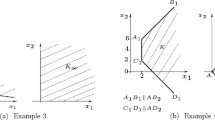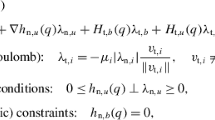Abstract
In this paper, the following problem is analyzed: Given a frictionless Lagrangian system subject to complementarity relations (due to a set of unilateral constraints) that define a linear complementarity problem whose matrix is the so-called Delassus’ matrix, study the influence of a set of bilateral constraints added to the dynamics on the Delassus’ matrix. Two main paths are followed: the Lagrange multipliers method and the reduced coordinates method. The link with optimization (the Gauss’ principle of mechanics) and the case of impacts, are also examined. The kinetic angles between the bilateral and the unilateral constraints are used to study the definiteness of the Delassus’ matrix.



Similar content being viewed by others
Notes
One also says functionally independent.
References
Acary, V., Brogliato, B.: Numerical Methods for Nonsmooth Dynamical Systems. Lecture Notes in Applied and Computational Mechanics, vol. 35. Springer, Berlin (2008)
Arponen, T.: Regularization of constraint singularities in multibody systems. Multibody Syst. Dyn. 6, 355–375 (2001)
Ballard, P.: The dynamics of discrete mechanical systems with perfect unilateral constraints. Arch. Ration. Mech. Anal. 154(3), 199–274 (2000)
Bernstein, D.S.: Matrix, Mathematics. Theory, Facts, and Formulas with Application to Linear Systems Theory. Princeton University Press, Princeton (2005)
Blajer, W.: Augmented Lagrangian formulation: geometrical interpretation and application to systems with singularities and redundancy. Multibody Syst. Dyn. 8, 141–159 (2002)
Brogliato, B.: Nonsmooth Mechanics, 2nd edn. Springer, London (1999)
Cottle, R.W.: On a problem in linear inequalities. J. Lond. Math. Soc. 43, 378–384 (1968)
Cottle, R.W., Pang, J.S., Stone, R.E.: The Linear Complementarity Problem, Computer Science and Scientific Computing. Academic Press, New York (1992)
Delassus, E.: Mémoire sur la théorie des liaisons finies unilatérales. Ann. Sci. Ec. Norm. Super., Ser. 3 34, 95–179 (1917)
Dzonou, R., Monteiro Marques, M.D.P.: A sweeping process approach to inelastic contact problems with general inertia operators. Eur. J. Mech. A, Solids 26(3), 474–490 (2007)
Dzonou, R., Monteiro Marques, M.D.P., Paoli, L.: A convergence result for a vibro-impact problem with a general inertia operator. Nonlinear Dyn. 58(1–2), 361–384 (2009)
Facchinei, F., Pang, J.S.: Finite-Dimensional Variational Inequalities and Complementarity Problems. Springer Series in Operations Research, vol. I. Springer, New York (2003)
Frémond, M.: Non-smooth Thermomechanics. Springer, Berlin (2002)
Génot, F., Brogliato, B.: New results on Painlevé paradoxes. Eur. J. Mech. A, Solids 18(4), 653–677 (1999)
Glocker, C.: Set-Valued Force Laws: Dynamics of Non-smooth Systems. Lecture Notes in Applied and Computational Mechanics, vol. 1. Springer, Berlin (2001)
Glocker, C.: Concepts for modeling impacts without friction. Acta Mech. 168(1–2), 1–19 (2004)
Glocker, C.: An introduction to impacts. In: Haslinger, J., Stavroulakis, G. (eds.) Nonsmooth Mechanics of Solids. CISM Courses and Lectures, vol. 485, pp. 45–102. Springer, New York (2006)
Glocker, C., Aeberhard, U.: The geometry of Newton’s cradle. In: Alart, P., Maisonneuve, O., Rockafellar, R.T. (eds.) Nonsmooth Mechanics and Analysis. Theoretical and Numerical Advances. AMMA, vol. 12, pp. 185–194. Springer, Berlin (2006)
Hiriart-Urruty, J.B., Lemaréchal, C.: Fundamentals of Convex Analysis. Grundlehren Text Editions. Springer, Berlin (2001)
Lancaster, P., Tismenetsky, M.: The Theory of Matrices, 2nd edn. Academic Press, New York (1985)
Leine, R.I., Nijmeijer, H.: Dynamics and Bifurcations of Non-smooth Mechanical Systems. Lecture Notes in Applied and Computational Mechanics, vol. 18. Springer, Berlin (2004)
Leine, R.I., van de Wouw, N.: Stability and Convergence of Mechanical Systems with Unilateral Constraints. Lecture Notes in Applied and Computational Mechanics, vol. 36. Springer, Berlin (2008)
Leine, R.I., van de Wouw, N.: Stability properties of equilibrium sets of non-linear mechanical systems with dry friction and impact. Nonlinear Dyn. 51, 551–583 (2008)
Lötstedt, P.: Mechanical systems of rigid bodies subject to unilateral constraints. SIAM J. Appl. Math. 42(2), 281–296 (1982)
Mabrouk, M.: A unified variational model for the dynamics of perfect unilateral constraints. Eur. J. Mech. A, Solids 17, 819–842 (1998)
Mangasarian, O.L.: Nonlinear Programming. McGraw-Hill, New York (1969)
McClamroch, N.H., Wang, D.: Feedback stabilization and tracking of constrained robots. IEEE Trans. Autom. Control 33(5), 419–426 (1988)
Monteiro Marques, M.D.P.: Differential Inclusions in Non-smooth Mechanical Problems: Shocks and Dry Friction. Birkhäuser, Boston (1993)
Moreau, J.J.: Les liaisons unilatérales et le principe de Gauss. C. R. Acad. Sci. Paris 256(4), 871–874 (1963)
Moreau, J.J.: Quadratic programming in mechanics: dynamics of one-sided constraints. SIAM J. Control 4(1), 153–158 (1966)
Moreau, J.J.: Unilateral contact and dry friction in finite freedom dynamics. In: Moreau, J.J., Panagiotopoulos, P.D. (eds.) Nonsmooth Mechanics and Applications. CISM Courses and Lectures, vol. 302, pp. 1–82. International Center for Mechanical Sciences, Springer, Berlin (1988)
Müller, A.: A Lie-group formulation of kinematics and dynamics of constrained MBS and its application to analytical mechanics. Multibody Syst. Dyn. 9, 311–352 (2003)
Müller, A.: A conservative elimination procedure for permanently redundant closure constraints in MBS-models with relative coordinates. Multibody Syst. Dyn. 16, 309–330 (2006)
Neto, M.A., Ambrosio, J.: Stabilization methods for the integration of DAE in the presence of redundant constraints. Multibody Syst. Dyn. 10, 81–105 (2003)
Or, Y., Rimon, E.: Investigation of Painlevé’s paradox and dynamic jamming during mechanism sliding motion. Nonlinear Dyn. 67(2), 1647–1668 (2012)
Paoli, L.: Continuous dependence on data for vibro-impact problems. Math. Models Methods Appl. Sci. (M3AS) 15(1), 1–41 (2005)
Paoli, L.: Time-stepping approximation of rigid-body dynamics with perfect unilateral constraints. I: The inelastic impact case. II: The partially elastic impact case. Arch. Ration. Mech. Anal. 198(2), 457–568 (2010)
Paoli, L.: A proximal-like method for a class of second order measure-differential inclusions describing vibro-impact problems. J. Differ. Equ. 250, 476–514 (2011)
Paoli, L., Schatzman, M.: Mouvement à nombre fini de degrés de liberté avec contraintes unilatérales: cas avec perte d’énergie. Modèl. Math. Anal. Numér. 27(6), 673–717 (1993)
Pfeiffer, F., Glocker, C.: Multibody Dynamics with Unilateral Contacts. Wiley, New York (1996)
Rockafellar, R.T.: Convex Analysis. Princeton Landmarks in Mathematics (1970)
Schatzman, M.: A class of nonlinear differential equations of second order in time. Nonlinear Anal. 2, 355–373 (1978)
Stronge, W.J.: Impact Mechanics. Cambridge University Press, Cambridge (2000)
Studer, C.: Numerics of Unilateral Contacts and Friction: Modeling and Numerical Time Integration in Non-smooth Dynamics. Lecture Notes in Applied and Computational Mechanics, vol. 47. Springer, Berlin (2009)
Acknowledgements
This work was performed with the support of the NSFC/ANR project Multiple Impact, ANR-08-BLAN-0321-01.
Author information
Authors and Affiliations
Corresponding author
Appendix: Useful mathematical results
Appendix: Useful mathematical results
1.1 A.1 Theorem 3.1.7 in [8] (excerpts)
Theorem 2
Let M∈ℝn×n be positive semidefinite, and let q∈ℝn be arbitrary. The following hold:
-
(a)
If z 1 and z 2 are two solutions of the LCP(M,q) then (z 1)T(q+Mz 2)=(z 2)T(q+Mz 1).
-
(d)
If M is symmetric (as well as positive semidefinite) then Mz 1=Mz 2 for any two solutions z 1 and z 2.
1.2 A.2 Theorem 3.8.6 in [8]
Theorem 3
Let M∈ℝn×n be copositive and let q∈ℝn be given. If the implication[0≤v⊥Mv≥0]⇒[v T q≥0] is valid, then the LCP(M,q) is solvable.
Notice that the implication can also be written as \(q \in Q_{M}^{*}\), with the notation of Remark 3.
1.3 A.3 Square root calculation
Consider the matrix  whose off-diagonal terms mimic the inertial couplings between the constraints. Since we can rewrite
whose off-diagonal terms mimic the inertial couplings between the constraints. Since we can rewrite  , calculating the square root of A boils down to calculating the square root of the sum of two matrices: a diagonal matrix that mimics the matrices D
h
and D
g
(which do no depend on the inertial coupling parameter ϵ), and a matrix with the off-diagonal terms and zero diagonal. Then lengthy but straightforward calculations yield
, calculating the square root of A boils down to calculating the square root of the sum of two matrices: a diagonal matrix that mimics the matrices D
h
and D
g
(which do no depend on the inertial coupling parameter ϵ), and a matrix with the off-diagonal terms and zero diagonal. Then lengthy but straightforward calculations yield
and:
where \(\mathcal{O}(\epsilon^{n})\) denotes terms of degree higher or equal to n, and the approximations are valid if |ϵ|<1. This simple example demonstrates that the approximations in Assumption 3 are not unrealistic.
1.4 A.4 Dorn’s duality and converse duality theorems
Theorem 4
[26, Theorems 8.2.4, 8.2.6] Let Q be a positive semidefinite and symmetric matrix. Consider the two quadratic programs:
and
Then:
-
If \(\bar{z}\) solves the program (89), then there exists \(\bar{w}\) such that \((\bar{z},\bar{w})\) solves the program (90). Moreover, the two extrema are equal.
-
If \((\bar{z},\bar{w})\) solves the program (90), then there exists \(\hat{z}\) with \(\hat{z}-\bar{z} \in \mathcal{N}(Q)\) such that \(\hat{z}\) solves the program (89).
1.5 A.5 Theorem 2.4.3 in [4]
Theorem 5
Let A∈ℝn×m. Then \(\mathcal{R}(A)^{\perp}=\mathcal{N}(A^{T})\), \(\mathcal{R}(A)=\mathcal{R}(AA^{T})\), and \(\mathcal{N}(A)=\mathcal{N}(A^{T}A)\).
1.6 A.6 Theorem 1 in [20] p. 194
Theorem 6
If A is idempotent then I−A is idempotent, \(\mathcal{R}(I-A)=\mathcal{N}(A)\), and \(\mathcal{N}(I-A)=\mathcal{R}(A)\).
1.7 A.7 Definition 3.1.1 in [4]
Definition 1
Let A∈ℝn×n. Then A is a projector if A is symmetric and idempotent.
1.8 A.8 Proposition 8.1.2 in [4]
Proposition 20
Let A and B be symmetric n×n matrices, and let S∈ℝm×n. If A≤B, then SAS T≤SBS T. If SAS T≤SBS T and rank(S)=n, then A≤B.
1.9 A.9 Exercise 8 in [20] p. 218
This exercise is reformulated here as a lemma for convenience.
Lemma 7
Let A be symmetric. Then the matrix I+ϵA is positive definite for sufficiently small real numbers ϵ.
Rights and permissions
About this article
Cite this article
Brogliato, B. Inertial couplings between unilateral and bilateral holonomic constraints in frictionless Lagrangian systems. Multibody Syst Dyn 29, 289–325 (2013). https://doi.org/10.1007/s11044-012-9317-8
Received:
Accepted:
Published:
Issue Date:
DOI: https://doi.org/10.1007/s11044-012-9317-8




